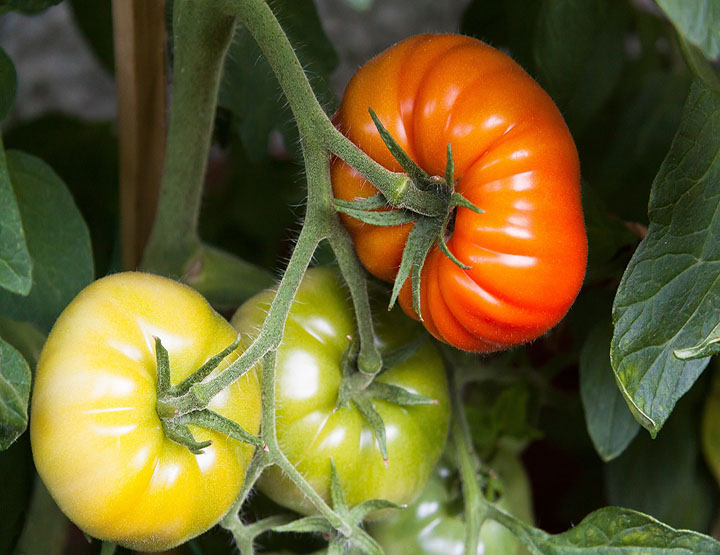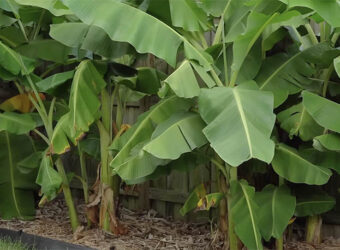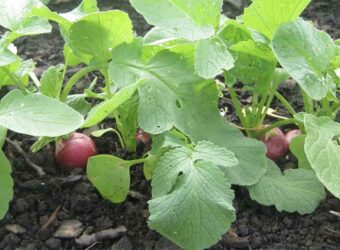When you think of home-grown veggies, tomatoes are likely the first thing to come to mind. And for good reason!
Eating a juicy tomato fresh from the garden is nothing like biting into the sad excuse of a tomato you often find in the store. And this flavor difference is just one reason why tomatoes are on the “must-grow” list of many gardeners.
These plants are also relatively easy to care for and provide a harvest that lasts weeks or even months. However, they’re not the only plant you should add to your garden!
Growing companion plants alongside your tomatoes can help keep these garden favorites healthy and productive. So whether you’re looking to manage pests, keep away weeds, or just make the most of your available garden space, check out these tomato companion plants.
What Are Companion Plants?
Companion plants are plants that provide benefits to their neighboring flora. They may help repel insect pests, suppress weeds, attract beneficial insects, or improve the soil.
It’s important to note that what may be a great companion plant for a tomato may be a poor companion for a cucumber. That’s why it’s helpful to think about each plant and its needs when you are planning your garden layout.
If you’re not sure of a tomato plant’s needs, don’t worry! I’ll guide you along to help you choose some plants that will grow well with your tomatoes.
Best Tomato Companion Plants
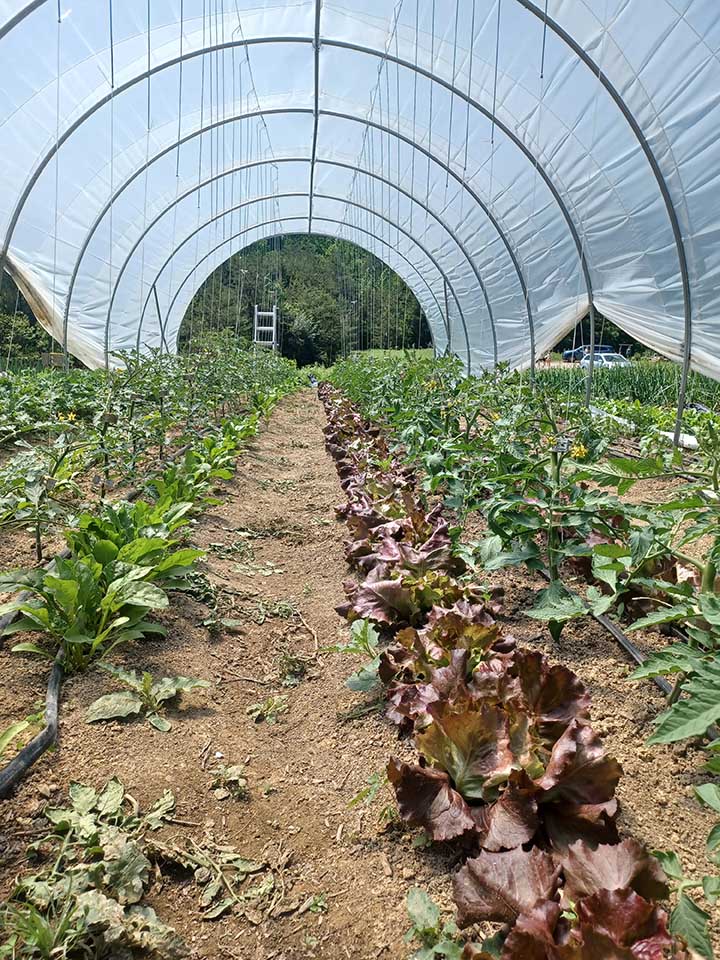
Wondering what to plant with your tomato plants? You’re in luck!
Tomato plants are happy growing next to a wide variety of crops, so you have a fair number of options. However, some of these options are better than others.
I’ll go over a list of companion plants that can grow well with tomato plants and help them thrive.
Best Tomato Companion Plants to Increase Predatory Insects
Unfortunately, critters other than humans love to dine on tomato plants. These pests can chew holes in otherwise perfect fruit, damage tomato leaves, and spread diseases between plants.
If you’re like me, you know how frustrating it is to see a perfect tomato one day and return to a worm-eaten fruit the next!
While spraying pesticides and hand-picking are two ways to control pests, they’re not your only options. You can also call on nature’s predators.
Predatory insects feed on pests ranging from aphids to caterpillars to stink bugs. These good bugs may already be present in your garden, but planting specific plants can draw them in and entice them to stay.
Some common predatory insects include green lacewings, ladybugs, assassin bugs, hoverflies, parasitic wasps, and tachinid flies. And while these pests are all different, they have one thing in common—their adult forms feed on nectar and pollen.
That means that planting flowering plants next to your tomatoes will help draw in these good bugs. And when the adults are in your garden, they can start laying eggs that will hatch into aphid-hungry larvae and inserting their eggs into tomato-hungry caterpillars.
With the above information in mind, consider planting one of the following plants with your tomatoes.
1. Sweet Alyssum
Since adult predatory insects like ladybugs, hoverflies, and parasitic wasps love flowers, they’re more likely to show up in your garden if sweet alyssum is around. This low-growing plant produces hundreds of tiny flowers that small insects love.
While the tiniest wasps have a difficult feeding on large flowers, they can dine on the pollen and nectar of the tiny alyssum flowers. And when these adults are in the garden, they’re likely to scout out caterpillars like tomato hornworms to lay their eggs in. When the eggs hatch, the larvae begin eating the hornworm from the inside out, leading to its death.
Bad for the hornworms but great for your tomato plants.
Sweet alyssum remains under a foot tall, which means it’s a great plant to tuck alongside tomato plants. Its short stature won’t hinder airflow and also allows for easy harvesting.
Since it remains so compact, you can plant it close to tomato plants. I like to place a few alyssum plants about a foot away from the base of my tomato plants.
While sweet alyssum is an annual, it tends to self-seed. That means new plants may continue to pop up both in the same year the originals were planted and in the years following.
Since sweet alyssum is a small plant, it’s also a great option for a patio garden. If you’re growing a tomato in a pot, you can place a potted sweet alyssum plant beside it to help attract good bugs.
2. Calendula
Calendula is another flowering plant that can attract predatory insects to your garden. These plants produce daisy-like flowers for months on end. And that means they supply a continuous supply of food for predatory insects like hoverflies, parasitic wasps, and green lacewings.
Calendula plants reach between one and two feet tall, so keep that in mind when planting them with your tomatoes. I like to leave at least 18 inches between tomato and calendula plants in order to allow for adequate airflow.
If you’d like to keep your calendula blooming throughout the season, it helps to deadhead the old flowers. You can also remove good-looking blooms.
The flowers can be used in bouquets, as edible flowers, or in topical medical preparations like salves and lip balms.
Since calendula is an annual, you’ll need to replant it in your garden each year.
3. Dill
While dill is frequently planted for its lacy, fragrant leaves, these plants also produce beautiful yellow umbels that contain many small, individual flowers. Small parasitic wasps and hoverflies particularly love dill’s tiny blooms.
With the adult forms of these insects in your garden, they are more likely to stick around and feed on tomato pests. Hoverfly larvae are voracious aphid predators, and parasitic wasps can help control caterpillars including tomato hornworms and armyworms.
Since dill plants produce foliage and then flowers, it’s possible to harvest some of their fragrant leaves and then let the plants go to flower.
I often tuck a row of dill plants about a foot away from my tomato plant rows. However, this close spacing means that I harvest the leaves and don’t let the plants go to flower.
If you’d like to capitalize on the dill flower’s abilities to attract good bugs, then you should plant dill at least three feet away from your tomato plants. That’s because flowering dill plants can reach three to four feet tall. This height can shade tomato plants and limit airflow, both of which you want to avoid.
4. Queen Anne’s Lace
Queen Anne’s lace is another plant that produces gorgeous umbels of tiny flowers that attract many predatory insects.
While you may think of Queen Anne’s lace as a wildflower or weed, you can grow the similar-looking false Queen Anne’s lace from seed. This plant is a different species, but it produces loads of flowers that attract the same good bugs.
These plants can reach over four-feet tall, so I like to leave at least three feet of space between Queen Anne’s lace and tomato plants. You can also plant this flower five or ten feet away from your tomatoes and still receive its insect-attracting benefits. That’s because most insects have no trouble traveling a few feet—especially if it means finding a good place to lay their eggs.
Best Tomato Companion Plants for Weed Control
Tomatoes, like all plants, are susceptible to competition from weeds. Whether you’re dealing with pigweed, dandelions, lambs quarter, purslane, or another garden weed, pulling weeds is no fun.
While I sometimes plant long-day crops like tomatoes into landscape fabric, I also turn to other plants to help control weeds. Quicking-growing crops can outcompete weeds, so I like to tuck them near the base of my tomato plants.
By the time these crops are crowding out your tomatoes, they’ll be ready to harvest.
5. Cilantro

Just like tomatoes and cilantro go together well in salsa, these plants can make a great pairing in the garden.
I like to plant a row of cilantro plants about a foot away from my tomato plants. The cilantro plants help with weed suppression and moisture conservation, and the tomato plants help shade the heat-sensitive cilantro.
If you want to maximize the weed-suppressing qualities of cilantro, I find it’s best to plant densely. One option is to direct seed the round cilantro seeds, spacing seeds about an inch or two apart.
You can also start seeds in plug trays. Place thee to five seeds in each plug and then transplant the seedlings about six inches apart.
Another benefit of cilantro is that it produces clusters of small white flowers. These flowers can help attract predatory insects like hoverflies, ladybugs, and parasitic wasps.
If you intend to let your cilantro plants go to flower, you’ll want to plant them a bit further away from your tomato plants. Four to five-foot spacing will allow for airflow between the plants while also allowing you to reach the tomatoes when it comes time to harvest.
6. Lettuce
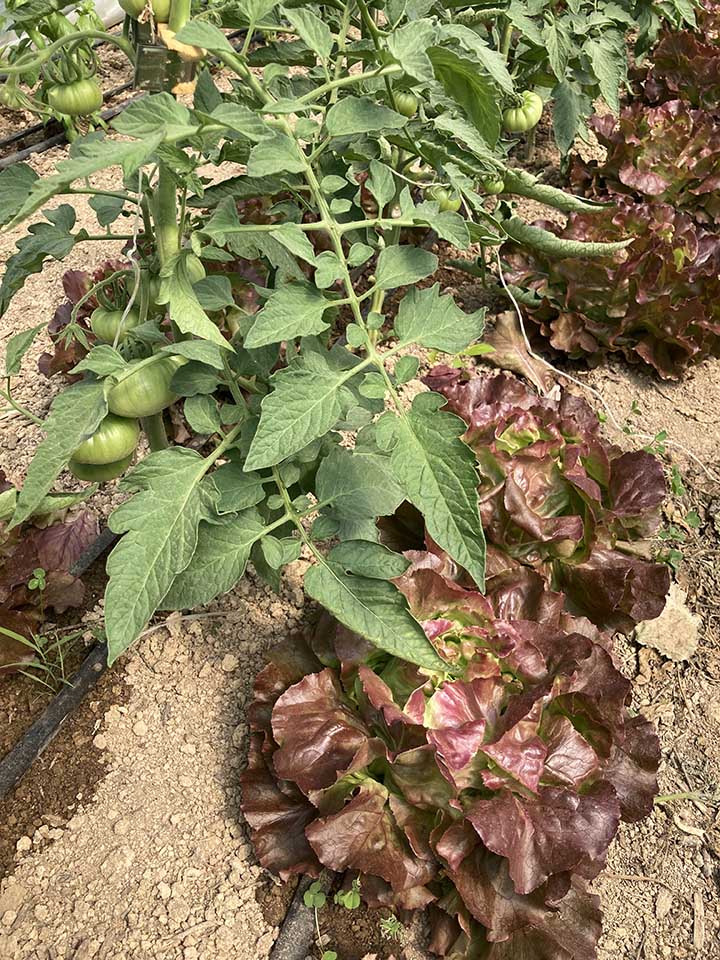
You may have heard that lettuce loves cool weather, and tomatoes flourish during long, hot summer days. And this is right!
However, since you plant tomato seedlings outdoors in the spring, there are a few months when tomato and lettuce plants happily coexist. I’ve found that planting head lettuce next to my tomato plants is a winning combination.
The lettuce seedlings will grow quickly and shade out germinating weed seeds. If all goes well, the lettuce will be ready to harvest about two months after transplanting—just before the first tomato fruits begin to ripen!
Any type of head lettuce will work well as a companion plant for tomatoes, including romaine, buttercrunch, and bibb. However, proper spacing is key.
I typically grow my tomato plants in a row and plant lettuce plants on either side of the tomato row. Planting the lettuce about 12–18 inches away from the tomato plants allows the lettuce to help with weeds while still allowing for adequate airflow.
7. Radishes
Radishes are one of my favorite crops to pop in next to slower-growing plants. That’s because they’re ready to harvest in as little as three weeks!
This quick time to maturity means that radishes grow quickly, and this attribute means they are great at competing with weeds. However, since radishes don’t provide much shade, they’ll only compete with weed seeds that germinate within a few inches of the plants.
But if you can get two crops in a space where you would normally only harvest one, why not go with two?
If you are planting your tomatoes in a row, you can tuck a row of radishes along both sides of the tomato row. I like to leave about a foot between the tomatoes and the radishes.
And if you have just a tomato plant or two in your garden, you can sprinkle radish seeds around the entire plant, leaving about a foot of space between the two crops.
It’s important to note that small radishes work better than storage types. That’s because larger varieties like daikon radishes and watermelon radishes mature better in the fall than they do in the spring.
8. Basil
Basil and tomatoes are a pairing I look forward to every summer. Whether they’re in pasta, bruschetta, or Caprese salad, these crops scream that warmer weather and longer days have arrived.
Not only are basil and tomatoes a great pairing in the kitchen, but they’re also great companions in the garden.
The smaller basil plants help to shade out weeds and conserve moisture around the tomato plants. Plus, their small white flower can help attract predatory insects.
Since both basil and tomatoes are susceptible to fungal diseases like powdery mildew, downy mildew, and late blight, it’s important to provide adequate spacing between plantings. I like to allow about 18–24 inches between these two summer plants.
Pruning the lower leaves off your tomato plants can help increase airflow and keep plants healthy. I like to remove the leaves from the bottom 12–18 inches of my tomato plants. However, make sure the plants are at least 36 inches tall before you prune.
Best Tomato Companion Plants to Attract Pollinators
Sure, little yellow tomato flowers are cute. But what we’re really after is the fruits! And pollinators are an essential part of turning these flowers into fruit.
Bees, flies, wasps, and butterflies may find their way into your garden on their own, but an abundance of flowering plants will encourage them to visit. And the more pollinators in your garden, the more likely it is that your tomato flowers will be pollinated.
If you want to increase the number of pollinators visiting your garden, consider planting a few of the following plants.
9. Yarrow
This perennial plant produces tall stalks topped with clusters of small flowers. Depending on the variety, the blooms may be white, pink, yellow, orange, or another shade.
Since yarrow is a perennial, you’ll want to think carefully before planting it in your garden. Because once it’s in the ground, it will come back year after year!
One good option is to use yarrow and other flowering perennial plants to create a border along the edge of your garden. The flowers will attract pollinators and predatory insects, and the foliage will provide a protective habitat for these good insects.
I personally love that yarrow can tolerate poor soils and drought. After the plants are well established they require very little care. And that means you can focus on tending to your tomato plants!
10. Bee Balm
Remember how I mentioned that perennial plants can make a great garden border or hedgerow? Well, bee balm is a must-have in any perennial planting.
Also known as wild bergamot or its genus Monarda, bee balm produces loads of attractive flowers in the summer and early fall.
While bee balm can tolerate a bit of drought, it will perform better in soil that is kept at least a little moist. It also grows best in soil that is rich in organic matter.
Since bee balm plants can grow over waist-high, you shouldn’t plant them too close to your tomato plants. I recommend at least five feet of space between bee balm and tomatoes.
11. Coneflower

The coneflower is one of my favorite flowering plants to attract pollinators. It produces lots of big blooms with purple-pink petals. Bees, butterflies, wasps, and other pollinators flock to the flowers to drink up their nectar and collect pollen.
Another big benefit of coneflowers is that they’re low maintenance and easy to care for. They can survive periods of drought and thrive in rocky and low-nutrient soils.
Plus, they’re perennials! That means you just have to plant them once and you can enjoy their beauty year after year.
Since coneflowers produce tall flower stalks and spread out a few feet, give them plenty of space. Planting them near the edge of your garden is often the best option.
12. Buckwheat
While many flowering plants are perennials, there are also plenty of annuals that attract pollinators. One of my favorites is buckwheat.
This fast-growing and tender plant is a great summer cover crop—a crop that is grown for its ecological benefits rather than to harvest. It quickly puts on biomass and also produces loads of sweet white flowers that attract bees, butterflies, and other pollinators.
Using buckwheat as a cover crop can increase the organic matter in your soil and support beneficial soil organisms.
The best time to plant buckwheat is in May, June, or July. If you follow this timeline, buckwheat will begin to produce flowers in about a month.
Once the plants start flowering (but before they set seed), you can mow or crimp the plants to kill them. This will enrich the soil and help support later crops.
While it’s tempting to allow the plants to continue to grow after they begin flowering, I advise against this. If the flowers go to seed, you’ll be weeding buckwheat out of your garden for months to come.
Frequently Asked Questions
What Plants Help Repel Tomato Pests?
While some people say that plants like marigolds and sage repel tomato plants, there’s little evidence to back this up. Rather than focusing on repelling tomato pests, you can plant plants that attract beneficial insects. These include sweet alyssum, dill, and calendula.
How Far Apart Should I Plant My Tomato Plants?
The distance between tomato plants depends on your trellising methods. If you plan on using tomato cages or a stake-and-weave method, plant tomatoes 18–24 inches apart.
However, if you plan on pruning and trellising your tomatoes using a single leader, you can space the plants 12–18 inches apart.
What Plants Should I Not Plant with Tomato Plants?
Tomato plants can grow well with most plants as long as they have adequate spacing. Avoiding growing any tall plants within three feet of tomato plants since this will limit airflow and increase the likelihood of disease development.
You should avoid growing cucumbers, winter squash, and melons close to your tomato plants since their sprawling nature can overtake the tomato plants.
Choose Tomato Companion Plants
If you want to limit weeds, help conserve soil moisture, and keep pests under control, utilizing companion plants can help. Tomatoes have many different suitable companion plants including lettuce, herbs, perennial flowers, and more.
